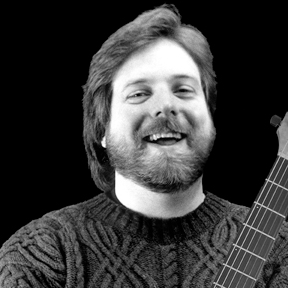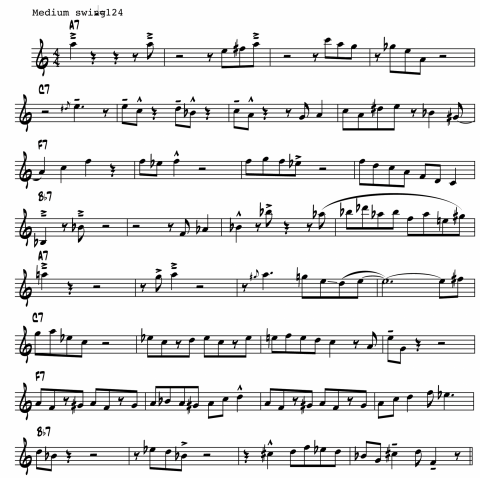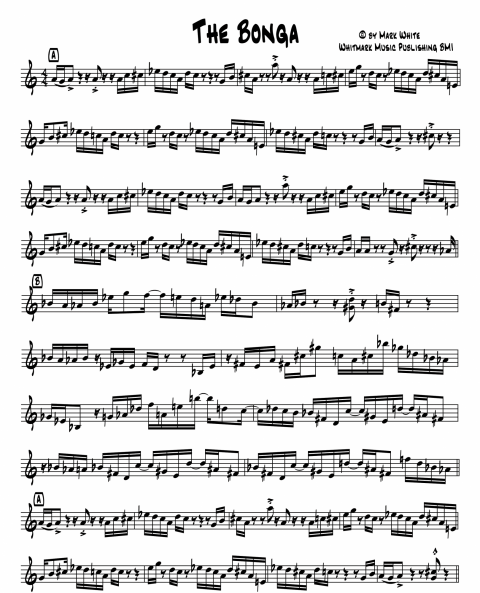Reading Skills: The Guitarist’s Nemesis?

Mark White, a Guitar Department faculty member, has performed and given clinics in Asia, South America, and Europe for Berklee’s international programs. His new book, Advanced Reading Etudes for Guitar, is available from Grescotmar Publications at www.grescotmar.com.
We’ve all heard the joke. “How do you get the guitar player to turn down? Put a chart in front of him.” It’s no secret that guitarists are notorious for their poor reading skills. There are several reasons why we have more trouble reading than other instrumentalists do. First, many guitarists don’t start playing until their teens. Most string, brass, and woodwind players begin their instrumental lessons during elementary school, and reading is usually the focus. These students play written music in
ensembles: concert band, wind ensemble, orchestra, and marching band. To participate, they have to read. Aside from classical music, music that features guitar prominently (jazz, rock, pop, blues, folk, r&b, country, etc.) generally is not part of the written tradition.
Many guitarists learn by ear, copying recordings of their favorite players. I consider this exercise to be the most important aspect of any guitarist’s musical training. This approach teaches a great deal about fingering, connectivity, nuance, and touch. But most guitarists who learn a piece from a recording will not formally write it down in traditional notation. Those who do try to document a transcription will frequently do so in tablature—useful for guitarists, but undecipherable to nonguitarists. While transcribing in this fashion is great for the ear, it’s not helpful for developing reading skills; and once again, the guitarist puts off learning to read.
Another reason why guitarists often don’t read well has to with how their instrument is tuned and laid out. With its six strings tuned predominantly in fourths, the guitar has duplicate notes all over the fingerboard. Keyboard instruments have only one location for a particular note—say middle C. That note might be played with any finger in the course of a piece, but it’s always in the same location. Horn players have valve or key fingerings that correspond to a note. Outside of the occasional false fingering or extended technique, they pretty much hit a note with a particular valve or key fingering. Not so with guitar. There are so many options for where guitarists can play a note that by the time they’ve decided where to play it, the band has moved on to the next piece! There is definitely a lag time associated with this location issue. We’ll come back to this issue in a while. Now that we’ve identified some reasons why guitarists tend to be weak readers, let’s look at how we all can sharpen reading skills.
For musicians to improve their reading, they have to know why they are having problems. Reading is equal parts experience, performance, ear training, and know-how. But initially you need to know which elements to concentrate on to improve. I’ve developed a method that breaks down the reading process into three areas of study. The first step involves the eye recognizing the note on the staff and translating it into a letter name (a basic musicianship skill).
Many musicians will do fairly well in naming the letter names of pitches that lie within or close to the staff. Try saying the letter names of the notes in example 1 as fast as you can. If you rattled off the pitch names pretty quickly, try going on to example 2. Most people are a bit slower reading below the staff and even slower reading ledger lines above the staff (see example 3). The cognitive ability to recognize any pitch in any register is an essential part of becoming a better sight reader. If you find yourself (or your student) fumbling for pitch names, train the eye to recognize the pitches faster. And since musicians typically have more trouble with low and high registers, I suggest you write out exercises like the examples. Don’t add rhythm, just whole notes with accidentals that are completely random and skip around the medium, low, and high registers. Practice training your eye until you get fast at naming the pitches.
Another eye-training exercise involves following a score or part while listening to a recording. Getting the sense of duration for each measure of music in meter and following the bars from system to system trains the eye to jump distances and get a sense of the spatial layout of the music as it relates to time. Coordinating the eye on the paper while following the music, along with moving around on the guitar neck to locate the pitches can be problematic for guitarists. Placing the music stand so that the field of view includes the neck of the guitar and the music can help.
Step two involves rhythm. This is frequently the weakest link for guitarists as well as other instrumentists. Typically, a musician with poor rhythm recognition gets behind in a piece, loses the sense of meter, and then crashes and burns. This is another basic musicianship skills issue that, like note recognition, can be practiced without the instrument in hand. In fact, guitarists may be better off not bringing note location and guitar technique into the process at this point. I recommend putting down the ax and conducting.
Conducting scares some people, but I find that it’s the best way of instilling a steady sense of meter while practicing rhythms. After some practice, the right hand (which conducts the beat patterns) will eventually start to move as if on auto pilot. Learning to sing rhythms accurately while keeping a steady beat pattern is an essential aspect of musicianship that will dramatically improve your reading ability. There are many good books with which to practice that specifically target rhythm studies. But you can practice conducting and singing rhythms with any piece of written music, from Real Book tunes to excerpts from a Beethoven symphony. Start with simple material, master it, and gradually work up to more difficult pieces.
The next step involves thinking about organizational and fingering concepts on your instrument. For guitarists, this is probably the most difficult issue to solve. Traditionally, many reading-oriented guitar methods start at the lower end of the fingerboard using a mix of open and stopped strings. They then work gradually higher on the neck incorporating transposable blocks of fingerings using only stopped strings that lie in a certain region or position on the guitar neck. It makes sense to start at the bottom and work up in the beginning and the in-position scale fingerings are valuable for organizing ideas because they are transposable. But, using these approaches exclusively for reading on the guitar tends to compromise the quality of phrasing, especially with jazz music. I’ve seen many guitarists try to read a jazz transcription in one position or with badly organized fingerings and get poor results. Generally, most contemporary guitarists think diagonally and move up and down the strings in addition to using fragments from in-position concepts when making fingering choices. This yields a more hornlike quality (which is good for jazz lines) and phrasing that fits modern guitar styles.

EX. 1

EX. 2

Ex. 3

EX. 4

EX. 5

EX. 6

Regardless of our instrument or how and where we choose our fingerings, one has to start cataloging the musical content of pieces in order to access these components on-demand for reading. Let’s analyze the content of a few examples. The notes in example 4 are a fragment of the Christmas tune “Deck the Halls.” They are predominantly scalar and entirely diatonic to C major. On the guitar, this melody could be played in “open” position utilizing open strings in the lowest part of the neck or in higher positions with no open strings. It might even be played entirely on one string (the fifth or sixth string).
A more difficult melody (see example 5) is excerpted from my tune “The Bonga.” It contains some passages that comprise poly pentatnics, polychordal, and chromatic elements. Because its register is limited to notes mainly in the staff, the content is playable in several places on the fingerboard. Experienced guitar readers, however, will aim for the classic pentatonic and arpeggio shapes to render the line. Most players make fingering decisions based on personal habits and style and on their understanding of what the music dictates. The aspect of recognizing and executing content is a universal reading skill that is a consideration for all instrumentalists. Once you’ve become proficient with the pitch identification and rhythm issues, start analyzing the music you’re trying to read for content. Try to understand the basic elements and determine the best fingerings and locations from the passages that contain recognizable scale fragments or arpeggio forms. These are highly visual and transposable on the guitar. In example 6, a sight-reading etude, try to find fingerings related to the given harmonies. Remember, guitarists, there isn’t just one way to play it; experiment!
The level of difficulty for these musical examples varies considerably. The “Bonga” fragment is at a professional level, the sight reading etude would be somewhere around fourth-semester level, and the Christmas tune is simple. They should give you a sense of you level of proficiency. Practice on similar material that is challenging and interesting, but not far beyond your ability. It’s best to start with music that you can play musically without making too many mistakes. This builds confidence—an important ingredient for developing reading skills. And there is a lot of material at all levels available commercially for reading practice. But regardless of your ability or instrument, applying the three areas of focus, combined with a little common sense and experience, will improve your reading.
I’ll conclude with the entire chart of my tune “The Bonga.” This is an example of a piece that would be very difficult to sight-read cold. Go through the steps I’ve outlined here and try it in smaller chunks of, say, four bars at a time. Use a metronome to keep yourself honest. Start slowly then gradually speed up the tempo. You can listen to an audio file of “The Bonga” online at www.berklee.edu/bt/172/lesson.html and play along with the recording. You might consider using one of the many transcription software aids available that slow down the tempo without changing the pitch.
By the way, have you heard the one about how many Berklee gutarists it takes to change a lightbulb?




